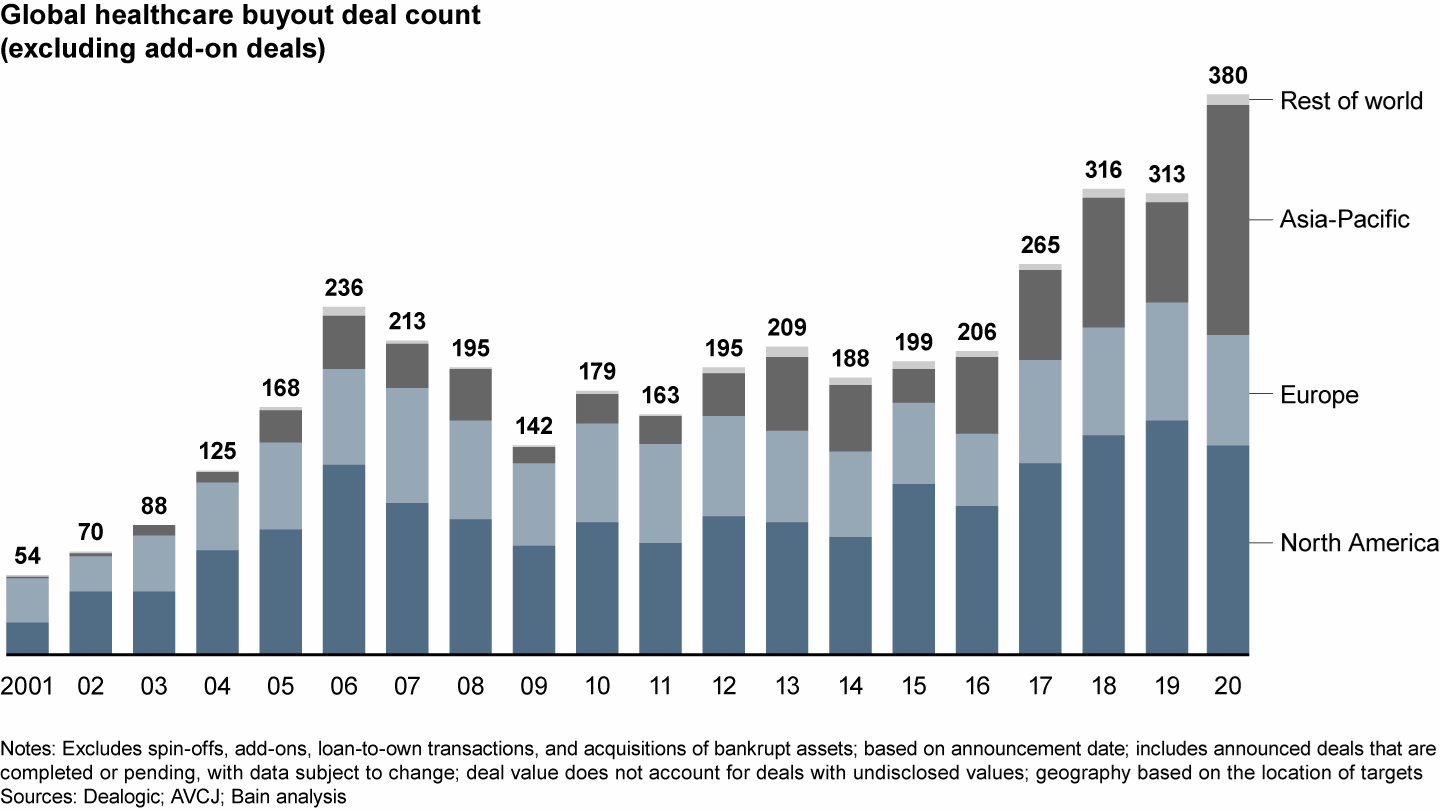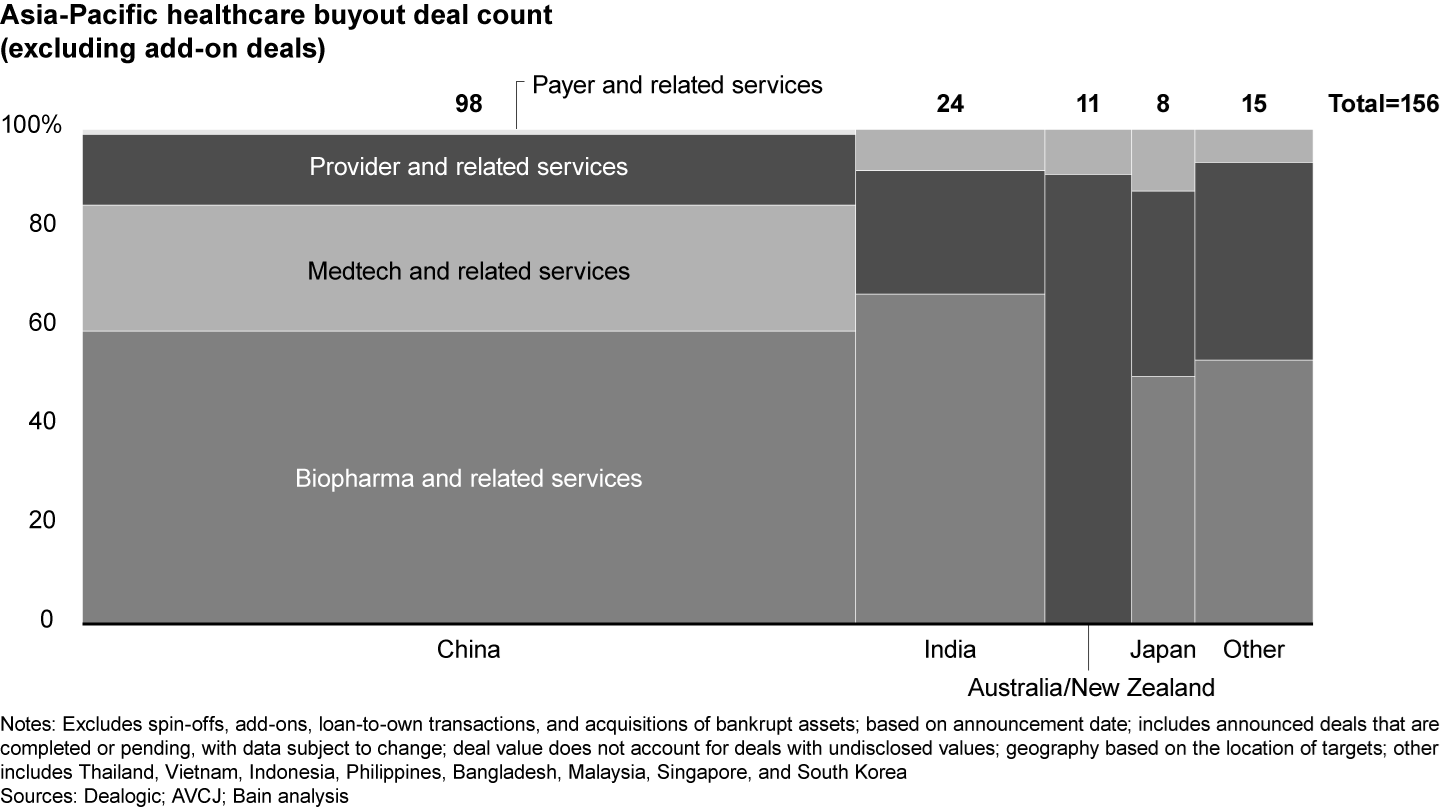Report

한눈에 보기
- Macro trends and favorable government policies again lifted healthcare activity in the region, which saw a surge in buyouts to a record high 156 deals during 2020, up from 68 in 2019. Disclosed value reached a new peak of $16.9 billion compared with $11 billion the year earlier.
- Biopharma fueled much of the rise as the most active sector, accounting for over half of the region’s deals.
- Asia-Pacific healthcare investors increasingly focused on domestic innovation in biopharma and medtech, especially in China where the government has supported development of local companies through various incentives.
- Healthcare IT buyouts, including health tech, through sponsor investments and initial public offerings also were active.
This article is part of Bain's 2021 Global Healthcare Private Equity and M&A Report.
We’ve kept an eye on small venture healthcare assets in the Asia-Pacific region for years, and 2020 demonstrated that these are evolving into growth equity opportunities for healthcare investors.
While other regions experienced declines in volume and disclosed value, the number of buyouts in Asia-Pacific during 2020 rose sharply to 156 deals, compared with 68 in 2019 (see Figure 1). Further, disclosed values in Asia-Pacific shot up to a new high of $16.9 billion, compared with $11 billion the prior year. Strong growth in biopharma fueled much of the rise as the most active sector, with 86 deals in 2020 vs. just 28 in 2019. Healthcare provider deals, historically the most active sector, saw a more modest increase to 39 for the year, up from 29. China led the way in overall activity, accounting for just over 60% of deals in the region, up from 41% in 2019 (see Figure 2).
Deal activity surged in Asia-Pacific, offsetting a decline in North America and Europe


Most Asia-Pacific healthcare deal activity occurred in China and India


Asia-Pacific investors have focused their sights on healthcare in hopes that their knowledge of the local landscape will give them an advantage. Increased appetite in capital markets for healthcare companies in the region has pushed valuations higher. Additionally, private equity sponsors have also become more willing to invest in early-stage assets alongside venture partners given misalignments in supply and demand for attractive, mature healthcare targets.
Meet the members of Bain’s Healthcare Private Equity practice.
Regional trends and government policies lift domestic companies
Underlying the region’s growth are several powerful macro trends: an aging population, increasingly affordable care, and a shift to universal healthcare coverage in markets such as India, Indonesia, and the Philippines.
In the policy arena, many governments are offering incentives for local manufacturing and development of healthcare products, such as China’s expanded reimbursement for innovative drugs. In parallel, governments are pressuring local and multinational incumbents through centralized volume-based drug and medtech procurement policies. These interventions should help level the playing field and fuel further local innovation, particularly in biopharma and medtech.
Besides these macro trends and government interventions, Asia-Pacific’s adoption of digital health solutions is quickly outpacing other regions, skipping some of the stages more mature economies passed through and going straight to next-generation solutions.
Healthcare providers: Hospital deals in emerging markets, non-hospital deals in established markets
Buyouts bumped up to 39 deals, compared with 29 in 2019, with a different emphasis in emerging and established markets.
In emerging markets with less developed provider infrastructure, investors tended to focus on hospital targets such as acute care centers providing multidisciplinary or general care. For example, GIC, the Singaporean sovereign wealth fund, in partnership with Vingroup, invested in the Vietnamese private hospital operator Vinmec for $203 million. A similar health center deal was made by TPG Growth, which purchased Apollo Hospitals Dhaka. Finally, KKR bought Saket City Hospitals as part of the Max Healthcare platform, its buy-and-build platform in India that went public in 2020.
In more developed markets, by contrast, non-hospital provider deals involving alternative sites or specialized care garnered more investor interest. Nichii Gaakan, a Japanese provider of senior care, was acquired by Bain Capital for $1.6 billion, the region’s largest provider deal for the year. Similarly, Juvis, a South Korean obesity treatment and management provider, was purchased by STIC Investments.
In Australia, interest in primary care providers jumped in 2020, highlighting the segment’s importance in the face of Covid-19. Private equity funds finally began to focus on scale platforms of general practice providers in the region. For instance, Healius, which operates medical centers across Australia, was acquired by BGH Capital for $343 million. Later in the year, Livingbridge invested in Better Medical and Smart Clinics, and intends to combine the two general practice groups to form the fifth-largest practice platform in the country.
Biopharma: A surge of activity
Activity exploded during the year with a marked increase in deals to 86, up from 28 in 2019. Several investment themes led the way.
First, investors continued to promote promising cell and gene therapies in developed markets. For instance, CARsgen Therapeutics, a clinical stage immuno-oncology firm focused on CAR T-cell therapies in China, received a $186 million investment from Loyal Valley Capital. Curocell, a South Korean developer of CAR T-cell therapies for cancer, also received a consortium investment.
Second, investors demonstrated greater willingness to take on molecule-specific risk in early-stage investments in China, where the government has invested to bring drug innovation onshore through various incentives. Of the 86 biopharma deals in the region, 58 were Chinese. Further, Chinese targets accounted for 16 of the 24 deals exceeding $100 million in disclosed value. For example, Hualan Biological Engineering, a China-based company engaged in the R&D of bacterial vaccines, viral vaccines, and plasma products, received a $290 million investment from Hillhouse.
The third theme concerns interest in Indian biopharma supply chain assets as the sector continues to diversify supply chains beyond China. JB Chemicals and Pharmaceuticals, a manufacturer for pharmaceutical formulations, received a roughly $410 million controlling stake investment from KKR, and Carlyle acquired a controlling stake in SeQuent, an animal health-focused pharmaceutical company, for $215 million.
Medtech: Developing local companies
Medtech experienced a surge in activity, reaching 30 deals for the year compared with 10 in 2019. Fully 25 of those 30 deals were with Chinese companies.
In China, the government has encouraged development of local medtech ecosystems and has instituted a volume-based procurement program to help local firms, with the government acting as a negotiator for all hospitals in the country. This has spurred investment interest in newly growing innovative local assets, especially for high-value consumables.
For example, Shanghai MicroPort CardioFlow Medtech, a producer of cardiac valve intervention devices, received investment from a consortium of buyers led by Hillhouse Capital for $130 million. Hillhouse also led a 2019 pre-IPO investment in Peijia Medical, a medtech developer focused on heart valve disease, and the company raised $348 million through an IPO in 2020.
Healthcare IT: Sponsor investments and IPOs
Healthcare IT, including health tech, logged only five deals, though sponsor investments and IPOs remained active channels for moving these assets. Trustbridge Partners, as well as Hillhouse Capital and Tencent Investment, led a $500 million investment in DXY, a leading Chinese digital health platform. And JD Health, the digital-health arm of the Chinese e-commerce company JD.com, received $830 million in pre-IPO investment from Hillhouse, then raised $3.5 billion through its IPO.
Searching for assets that show early signs of a rebound
Given the growth trajectory that Asia-Pacific has shown, we expect investors to continue showing keen interest here, especially considering the sharp growth of local innovation from high-tech biopharma and medtech targets and the strong demand for high-quality care in emerging Asia-Pacific. As private equity funds look for ways to put their capital to work, we expect fast transactions for those assets that can show early signs of returning to past performance levels. A few themes should continue to play front and center in the region:
- diversification of supply chains for medtech and biopharma, to reduce risk to drug and device developers;
- a growing need for healthcare IT and digital solutions that fit within the region’s provider models; and
- provider growth fueled by the reopening of medical tourism markets after the pandemic abates.
More from the report
-
Welcome Letter: Fertile Conditions for Healthcare Private Equity Investment
-
Healthcare Private Equity Market 2020: The Year in Review
-
The Covid-19 Paradox: Widespread Repercussions for Demand, but New Healthcare Investment Opportunities as Well
-
Healthcare Private Equity in North America: Bring On the Gem Assets
-
Healthcare Private Equity in Europe: Steady Dealmaking despite Many Deferrals
-
Healthcare Private Equity in Asia-Pacific: Riding a Wave of Domestic Innovation
-
Healthcare Providers: New Roll-Up Candidates and a New Look for Risk-Bearing Providers
-
Healthcare Payers: A Bid to Reduce Costs for Patients and Employers
-
Biopharma: Commercialization Support Services Are Thriving
-
Medtech: Four Themes Fueled Deals despite the Pandemic
-
Healthcare IT: Technologies Help Improve Patient Experiences at Lower Costs
-
Healthcare M&A: A Pandemic-Induced Slowdown in Every Sector
-
Healthcare Exit Activity: Robust Capital Markets Spur a Surge of IPOs
-
Healthcare Private Equity Outlook: 2021 and Beyond